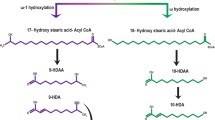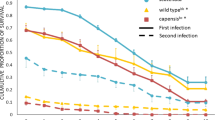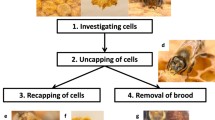Abstract
Social parasites exploit their host’s communication system to usurp resources and reproduce. In the honeybee, Apis mellifera, worker reproduction is regulated by pheromones produced by the queen and the brood. Workers usually reproduce when the queen is removed and young brood is absent. However, Cape honeybee workers, Apis mellifera capensis, are facultative intraspecific social parasites and can take over reproduction from the host queen. Investigating the manner in which parasitic workers compete with host queens pheromonally can help us to understand how such parasitism can evolve and how reproductive division of labour is regulated. In A. m. capensis, worker reproduction is associated with the production of queen-like pheromones. Using pheromonal contest experiments, we show that Apis mellifera scutellata queens do not prevent the production of queen-like mandibular gland compounds by the parasites. Given the importance of these pheromones in acquiring reproductive status, our data suggest that the single invasive lineage of parasitic workers occurring in the range of A. m. scutellata was selected for its superior ability to produce these signals despite the presence of a queen. Such resistance was indeed less frequent amongst other potentially parasitic lineages. Resistance to reproductive regulation by host queens is probably the key factor that facilitates the evolution of social parasitism by A. m. capensis workers. It constitutes a mechanism that allows workers to evade reproductive division of labour and to follow an alternative reproductive option by acquiring direct fitness in foreign colonies instead of inclusive fitness in their natal nests.



Similar content being viewed by others
References
Akre RD, Garnett WB, MacDonald JF, Greene A, Landolt P (1976) Behavior and colony development of Vespula pensylvanica and V. atropilosa (Hymenoptera: Vespidae). J Kans Entomol Soc 49:63–84
Allsopp MH (1993) Summarized overview of the capensis problem. S Afr Bee J 65:127–136
Allsopp MH, Crewe RM (1993) The Cape honeybee as a Trojan horse rather than the hordes of Jenghiz Khan. Am Bee J 133:121–123
Barbier J, Lederer E (1960) Structure chimique de la substance royale de la reine de l’abeille. C R Acad Sci Paris Série D 251:1131–1135
Baudry E, Kryger P, Allsopp M, Koeniger N, Vautrin D, Mougel F, Cornuet JM, Solignac M (2004) Whole-genome scan in thelytokous-laying workers of the Cape honeybee (Apis mellifera capensis): central fusion, reduced recombination rates and centromere mapping using half-tetrad analysis. Genetics 167:243–252
Beekman M, Wossler TC, Martin SJ, Ratnieks FLW (2002) Parasitic honeybee workers (Apis mellifera capensis) are not given preferential treatment by African guards (A. m. scutellata). Insectes Soc 49:216–220
Birmingham AL, Hoover SE, Winston ML, Ydenberg RC (2004) Drifting bumble bee (Hymenoptera: Apidae) workers in commercial greenhouses may be social parasites. Can J Zool 82:1842–1853
Breed MD, Diaz PH, Lucero KD (2004) Olfactory information processing in honeybee, Apis mellifera, nestmate recognition. Anim Behav 68:921–928
Callow RK, Johnston NC (1960) The chemical constitution and synthesis of queen substances of honeybees (A. mellifera L.). Bee World 41:152–153
Crewe RM (1982) Compositional variability: the key to the social signals produced by honeybee mandibular glands. In: Breed MD, Michener CD, Evan HE (eds) The biology of social insects. Westview, Boulder, CO, pp 318–322
Crewe RM (1984) Differences in behaviour and morphology between capensis and adansonii. S Afr Bee J 56:16–21
Crewe RM (1988) Natural history of honey-bee mandibular gland secretions: development of analytical techniques and the emergence of complexity. In: Needham GR, Page RE, Delfinado-Baker M, Bowman CE (eds) Africanized honeybees and bee mites. Ellis Horwood, Chichester, pp 149–158
D’Ettore P, Heinze J (2001) Sociobiology of slave-making ants. Acta Ethol 3:67–82
Dietemann V, Lubbe A, Crewe RM (2006) Human factors facilitating the spread of a parasitic honeybee in South Africa. J Econ Entomol 99:7–13
Härtel S, Neumann P, Raassen FS, Moritz RFA, Hepburn HR (2006a) Social parasitism by Cape honeybee workers in colonies of their own subspecies (Apis mellifera capensis Esch.). Insectes Soc (In press)
Härtel S, Neumann P, Kryger P, von der Heide C, Moltzer, G-J, Crewe RM, van Praagh JP, Moritz RFA (2006b) Infestation levels of Apis mellifera scutellata swarms by socially parasitic Cape honeybee workers (Apis mellifera capensis Esch.). Apidologie (In press) DOI: 10.1051/apido:2006012
Hemmling C, Koeniger N, Ruttner F (1979) Quantitative Bestimmung der 9-Oxodecensäure im Lebenszyklus der Kapbiene (Apis mellifera capensis Escholtz). Apidologie 10:227–240
Hepburn HR (1992) Pheromonal and ovarian development covary in Cape Honeybees, Apis mellifera capensis. Naturwissenschaften 79:523–524
Hepburn HR (1994) Reproductive cycling and hierarchical competition in Cape honeybees, Apis mellifera capensis Esch. Apidologie 25:38–48
Hepburn HR, Crewe RM (1991) Portrait of the Cape honeybee, Apis mellifera capensis. Apidologie 22:567–580
Hepburn HR, Radloff SE (1998) Honeybees of Africa. Springer, Berlin Heidelberg New York
Hillesheim E, Koeniger N, Moritz RFA (1989) Colony performance in honeybees (Apis mellifera capensis) depends on proportion of subordinate and dominant workers. Behav Ecol Sociobiol 24:291–296
Hölldobler B, Wilson EO (1990) The ants. Springer, Berlin Heidelberg New York
Hoover SER, Keeling CI, Winston ML, Slessor KN (2003) The effect of queen pheromones on worker honey bee ovary development. Naturwissenschaften 90:477–480
Hoover SER, Winston ML, Oldroyd BP (2005) Retinue attraction and ovary activation: response of wild type and anarchistic honeybees (Apis mellifera) to queen and brood pheromones. Behav Ecol Sociobiol 59:278–284
Hoover SER, Higo HA, Winston ML (2006) Worker honeybee ovary development seasonal variation and the influence of larval and adult nutrition. J Comp Physiol B 176:55–63
Jay SC (1972) Ovary development of worker honeybees when separated from worker brood by various methods. Can J Zool 50:661–664
Johannsmeier MF (1983) Experiences with the Cape bee in the Transvaal. S Afr Bee J 55:130–138
Katzav-Gozansky T, Soroker V, Hefetz A (2002) Honeybees Dufour’s gland—idiosyncrasy of a new queen signal. Apidologie 33:525–537
Keeling CI, Slessor KN, Higo HA, Winston ML (2003) New components of the honey bee (Apis mellifera L.) queen retinue pheromone. Proc Natl Acad Sci USA 100:4486–4491
Keller L, Nonacs P (1993) The role of pheromone in social insects: queen control or queen signal? Anim Behav 45:787–794
Koeniger N, Würkner W (1992) Die Kap Honigbienen (Apis mellifera capensis) Natürliche Verbreitung und die Schwierigkeiten der Haltung unter unseren klimatischen Bedingungen. Die Biene 128:583–588
Kryger P (2001) The Capensis pseudo-clone, a social parasite of African honey bees. In: Proceedings of the 2001 Berlin Meeting of the European Section of IUSSI, p 208
Lenoir A, D’Ettorre P, Errard C (2001) Chemical ecology and social parasitism in ants. Annu Rev Entomol 46:573–599
Lopez-Vaamonde C, Koning JW, Brown RM, Jordan WC, Bourke AFG (2004) Social parasitism by male-producing reproductive workers in a eusocial insect. Nature 430:557–560
Lundie AE (1954) Laying workers produce worker bees. S Afr Bee J 29:10–11
Martin S, Wossler TC, Kryger P (2002a) Usurpation of Apis mellifera scutellata colonies by A. m. capensis workers. Apidologie 33:215–232
Martin SJ, Beekman M, Wossler TC, Ratnieks FLW (2002b) Parasitic Cape honeybee workers, Apis mellifera capensis evade policing. Nature 415:163–165
Michener CD (2000) The bees of the world. The Johns Hopkins University Press, Baltimore Maryland
Montague CE, Oldroyd BP (1998) The evolution of worker sterility in honey bees: an investigation into a behavioural mutant causing failure of worker policing. Evolution 52:1408–1415
Moritz RFA, Hillesheim E (1985) Inheritance of dominance in honeybees (Apis mellifera capensis Esch.). Behav Ecol Sociobiol 17:87–89
Moritz RFA, Haberl M (1994) Lack of meiotic recombination in thelytokous parthenogenesis of laying workers of Apis mellifera capensis (the Cape honeybee). Heredity 73:98–102
Moritz RFA, Kryger P, Allsopp MH (1999) Lack of worker policing in the Cape honey bee (Apis mellifera capensis) Behaviour 136:1079–1092
Moritz RFA, Simon UE, Crewe RM (2000) Pheromonal contest between honeybee workers. Naturwissenschaften 87:395–397
Moritz RFA, Lattorff HMG, Crewe RM (2004) Honeybee workers (Apis mellifera capensis) compete for producing queen-like pheromone signals. Proc R Soc Lond B Biol Sci 271(Suppl 3):98–100
Nanork P, Paar J, Chapman NC, Wongsiri S, Oldroyd BP (2005) Asian honeybees parasitize the future dead. Nature 437:829
Naumann K, Winston ML, Slessor K, Prestwich GD, Webster FX (1991) Production and transmission of honey bee queen (Apis mellifera L.) mandibular gland pheromone. Behav Ecol Sociobiol 29:321–332
Neumann P, Hepburn HR (2002) Behavioural basis for social parasitism of Cape honeybees (Apis mellifera capensis Esch.). Apidologie 33:165–192
Neumann P, Moritz RFA (2002) The Cape honeybee phenomenon: the sympatric evolution of a social parasite in real-time. Behav Ecol Sociobiol 52:271–281
Neumann P, Radloff SE, Hepburn HR (2002) Parasitic Cape bees in the northern regions of South Africa: source of the founder population. S Afr J Sci 98:404–406
Oldroyd BP, Smolenski AJ, Cornuet JM, Crozier RH (1994) Anarchy in the beehive. Nature 371:749
Onions GW (1912) South African “fertile-worker bees”. S Afr Agric J 1:720–728
Pankiw T, Winston ML, Plettner E, Slessor KN, Pettis JS, Taylor OR (1996) Mandibular gland components of European and Africanized honey bee queens. J Chem Ecol 22:605–615
Pirk CWW, Neumann P, Ratnieks FLW (2003) Cape honeybees, Apis mellifera capensis, police worker-laid eggs despite the absence of relatedness benefits. Behav Ecol 14:347–352
Pirk CWW, Neumann P, Hepburn HR, Moritz RFA, Tautz J (2004) Egg viability and worker policing in honeybees. Proc Natl Acad Sci USA 101:8649–8651
Plettner E, Slessor KN, Winston ML, Robinson GE, Page RE (1993) Mandibular gland components and ovarian development as measures of caste differentiation in the honey bee (Apis mellifera L.). J Insect Physiol 39:235–240
Ratnieks FL (1993) Egg-laying, egg-removal, and ovary development by workers in queenright honeybee colonies. Behav Ecol Sociobiol 32:191–198
Ratnieks FLW, Visscher PK (1989) Worker policing in the honeybee. Nature 342:796–797
Ruttner F (1980) Königinnenzucht. Apimondia, Bukarest
Ruttner F, Koeniger N (1976) Queen substance bei eierlegenden Arbeiterinnen der Honigbiene (Apis mellifera L.). Naturwissenschaften 9:434–435
Sakagami SF (1958) The false queen: fourth adjustive response in dequeened honeybee colonies. Behaviour 13:280–296
Sasaki T, Tsuji K (2003) Behavioral property of the unusual large workers in the ant, Pristomyrmex pungens. J Ethol 21:145–151
Schäfer MO, Dietemann V, Pirk CWW, Neumann P, Crewe RM, Hepburn HR, Tautz J, Crailsheim K (2006) Pollen consumption and worker reproduction in Cape honeybees (Apis mellifera capensis Esch.) J Comp Physiol (In press) DOI 10.1007/s00359-006-0112-y
Schmid-Hempel P (1998) Parasites in social insects. Princeton University Press, Princeton, NJ
Simon UE, Moritz RFA, Crewe RM (2001) The ontogenetic pattern of mandibular gland components in queenless worker bees (Apis mellifera capensis Esch.). J Insect Physiol 47:735–738
Simon U, Moritz RFA, Crewe RM (2005) Reproductive dominance among honeybee workers in experimental groups of Apis mellifera capensis. Apidologie 36:413–419
Slessor KN, Kaminski LA, Ki GGS, Borden JH, Winston ML (1988) Semiochemical basis of the retinue response to queen honey bees. Nature 332:354–356
Slessor KN, Kaminski LA, King GGS, Winston ML (1990) Semiochemicals of the honey bee queen mandibular glands. J Chem Ecol 16:851–860
Slessor KN, Winston ML, Le Conte Y (2005) Pheromone communication in the honeybee. J Chem Ecol 31:2731–2745
Tribe GD (1981) Cape honeybee behaviour. S Afr Bee J 53:10–12
Tsuji K (1995) Reproductive conflicts and levels of selection in the parthenogenetic ant, Pristomyrmex pungens: contextual analysis and partitioning of covariance. Am Nat 146:586–607
van der Blom J (1991) Social regulation of egg-laying by queenless honeybee workers (Apis mellifera L.). Behav Ecol Sociobiol 29:341–346
Velthuis HHW, van der Kerk A (1988) Age, environment, and genes in relation to the mandibular gland secretion of pure and hybrid Apis mellifera capensis worker bees. In: Needham GR, Page RE, Delfinado-Baker M, Bowman CE (eds) Africanized honeybees and bee mites. Ellis Horwood, Chichester, pp 80–86
Velthuis HHW, Ruttner F, Crewe RM (1990) Differentiation in reproductive physiology and behaviour during the development of laying worker honeybees. In: Engels W (ed) Social insects. Springer, Berlin Heidelberg New York, pp 231–243
Vierling G, Renner M (1977) Secretion of tergite glands and attractiveness of honey bee queen. Behav Ecol Sociobiol 2:185–200
Visscher PK (1989) A quantitative study of worker reproduction in honey bee colonies. Behav Ecol Sociobiol 25:247–254
Visscher PK (1996) Reproductive conflict in honey bees: a stalemate of worker egg-laying and policing. Behav Ecol Sociobiol 39:237–244
Visscher PK, Dukas R (1995) Honey bees recognise development of nestmates’ ovaries. Anim Behav 49:542–544
Wilson EO (1971) The insect societies. Cambridge, Harvard University Press
Winston ML, Slessor KN (1998) Honey bee primer pheromones and colony organization: gaps in our knowledge. Apidologie 29:81–95
Wossler TC, Crewe RM (1999) Honey bee tergal gland secretion affects ovarian development in caged workers. Apidologie 30:311–320
Woyke J (1995) Invasion of Capensis bee. In: Magnuson P (ed) Proceedings of the first international electronic conference on the Cape bee problem in South Africa. Plant Protection Research Institute, Pretoria, South Africa, p 35
Acknowledgements
Financial support was granted by the Volkswagen Foundation, the National Research Foundation of South Africa and the University of Pretoria to VD and RMC, by the DFG to JP and by an Emmy Noether fellowship of the DFG to PN. These experiments comply with the current laws of South Africa.
Author information
Authors and Affiliations
Corresponding author
Additional information
Communicated by J. Traniello
Rights and permissions
About this article
Cite this article
Dietemann, V., Pflugfelder, J., Härtel, S. et al. Social parasitism by honeybee workers (Apis mellifera capensis Esch.): evidence for pheromonal resistance to host queen’s signals. Behav Ecol Sociobiol 60, 785–793 (2006). https://doi.org/10.1007/s00265-006-0222-0
Received:
Revised:
Accepted:
Published:
Issue Date:
DOI: https://doi.org/10.1007/s00265-006-0222-0




